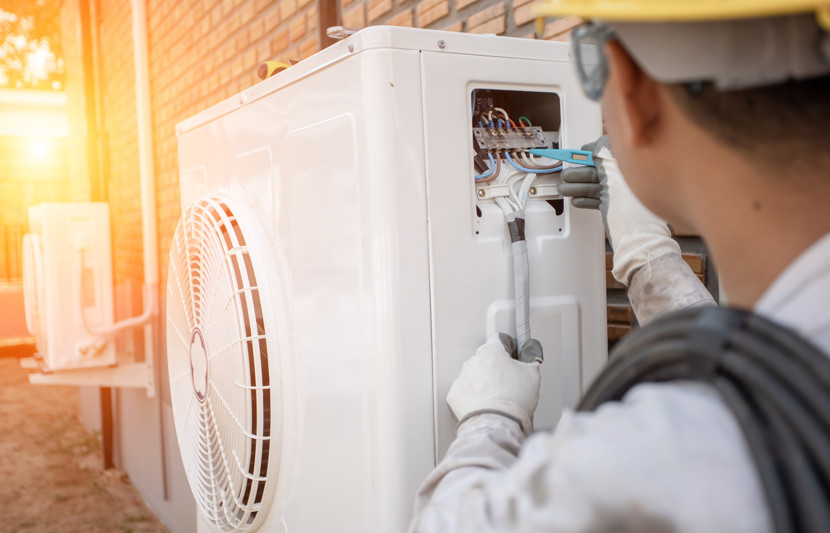

Heat pumps
Heat pumps are hot on the agenda since the UK Government's Heat and Building Strategy outlining the crucial role these low carbon heating systems will play in the race to Net Zero.
With the goal to eliminate new fossil-fuel boilers by 2035, switching to these renewable energy sources can not only lead to savings on fossil fuels, but also the reduction in greenhouse gas emissions.
What are heat pumps and why are they important?
The UK Government has ruled that gas boilers will be banned in all new homes by 2025, and as of 2021, all new homes will be expected to achieve a 31% reduction in carbon emissions. There is now a compelling argument that heat pumps should be the heating technology of choice for most developers, particularly in residential schemes.
Although they use a small amount of electricity to run, heat pumps are considered highly efficient because they don't depend on the burning of fossil fuels to create heat. Instead, a heat pump takes thermal energy from the air, ground or water, and transfers it into heat to be circulated around a heating and hot water system.
By capturing heat that is already present in the environment, the system itself does not burn any fuel and therefore emits no carbon dioxide. They also perform well and can provide heating during the winter, even at temperatures of -20 degrees Celsius.
What types of heat pumps should you install?
Heat pumps can deliver significant carbon savings helping to comply with building regulations. There are two most common types of heat pumps; air source and ground source - but which should you be installing and why?

Ground source heat pumps
Ground-source heat pumps, sometimes called Geothermal heat pumps, transfer heat between the ground outside and the air inside.
Although these are more expensive to install, they are typically more efficient and have a lower operating cost. This is due to the consistency of the ground temperature throughout the year. Ground source heat pumps do require a large garden or piece of land to be installed, resulting in excavation costs.
Ground source heat pumps are typically used on new builds as they are easier to install during the early project stages when work is at ground level.

Air source heat pumps
More popular for residential heating and cooling, air-source heat pumps transfer heat between indoor air and outdoor air.
Used in the right way, and in the right place, air source heat pumps provide a good, viable and cost-effective option. To install an air source heat pump, an external condenser unit sits in a box on the outside wall, overall making it cheaper to install in comparison to ground source heat pumps.
Air source heat pumps work are typically used for retrofit projects.

How a heat pump works
Heat pump systems move (or pump) heat from one place to another by using a compressor and a circulating structure of liquid or gas refrigerant. Through this, the heat is extracted from outside sources and then pumped indoors.

Understanding performance: energy efficiency
One of the main benefits of heat pumps is that they’re an incredibly energy efficient heating method. Ground and air source heat pump efficiencies can exceed 300% since they transfer heat rather than generate it.
When measuring heat pump efficiency, we use the parameter of CoP = “Coefficient of performance”
COP is the ratio of how much useful heat a heat pump will produce under the best possible conditions if we give it a certain energy input. Using this scale, commercial air source heat pump can be as high as 4, whereas ground source heat pumps can reach up to 5. This means that for every unit of electricity you put in, the heat pumps have the potential to produce 4 and 5 units of heat respectively.
The benefits of heat pumps
Low-carbon heating - As carbon-neutral systems, heat pumps can improve scores for Standard Assessment Procedure (SAP) rating building regulations, they achieve 70% carbon savings compared to gas, and they can offer an easier and cheaper way to attain carbon compliance.
Conforms to Building Standards - Heat pumps ensure housing developments conform to stringent building regulations and meet Future Homes Standards. They can also help commercial buildings comply with Minimum Energy Efficiency Standards.
Ideal for large-scale projects - Multiple ground-source heat pumps can be connected through a district heating network known as Shared Ground Loop Arrays. The design can reduce ground array costs and time, utilise waste heat, provide cooling and prevent overheating.
Maximise profitability - Ground source heat pumps can increase usual space in developments. This can increase kerb appeal by avoiding the use of external heating units. By adding an energy-efficient and low carbon heat pump, this could appeal to purchasers, which can reflect in the sale price.
Webinar: Reducing carbon emissions on development sites
Watch on demand
Watch our Leading Minds Webinar to explore individual building measures and site wide energy strategies that a development can use to meet all the social, economic and environmental tenets of a sustainable design.
Presented by Simon Bourke, Head of Building Services UK

No Content Set
Exception:
Website.Models.ViewModels.Blocks.PageBlocks.CardBlocks.RelatedProjectCardBlockVm


